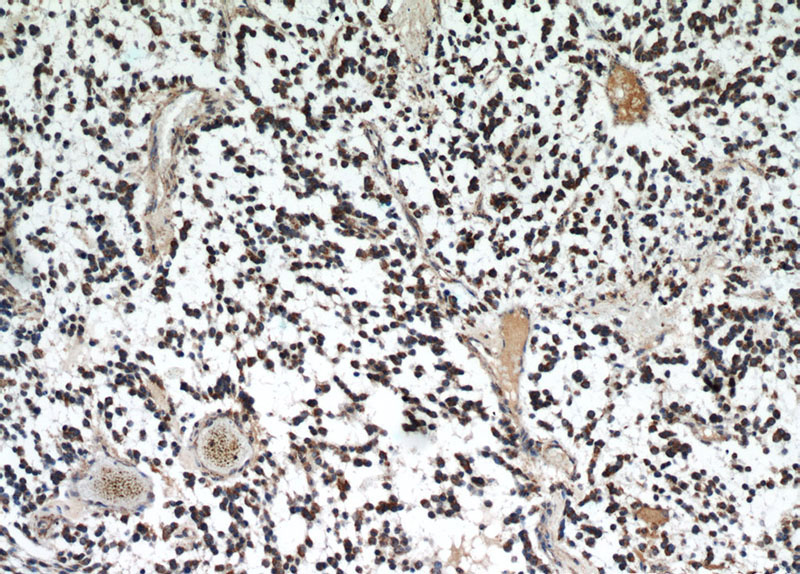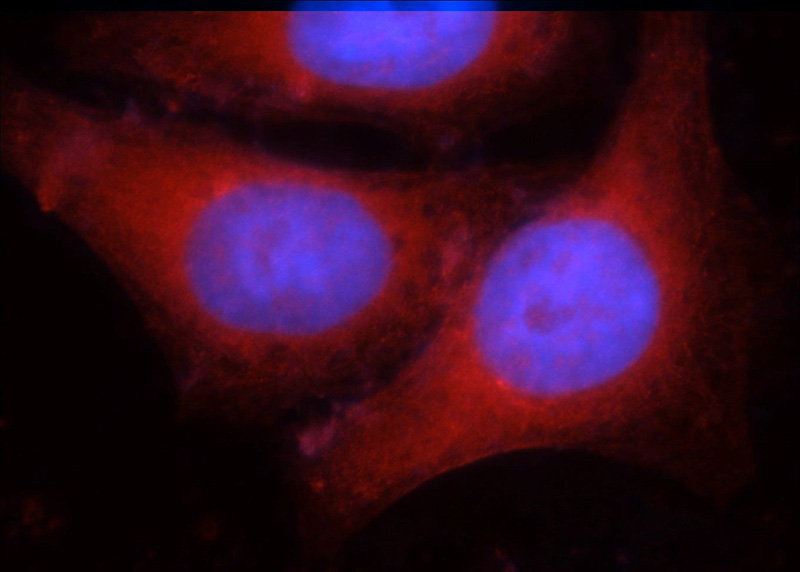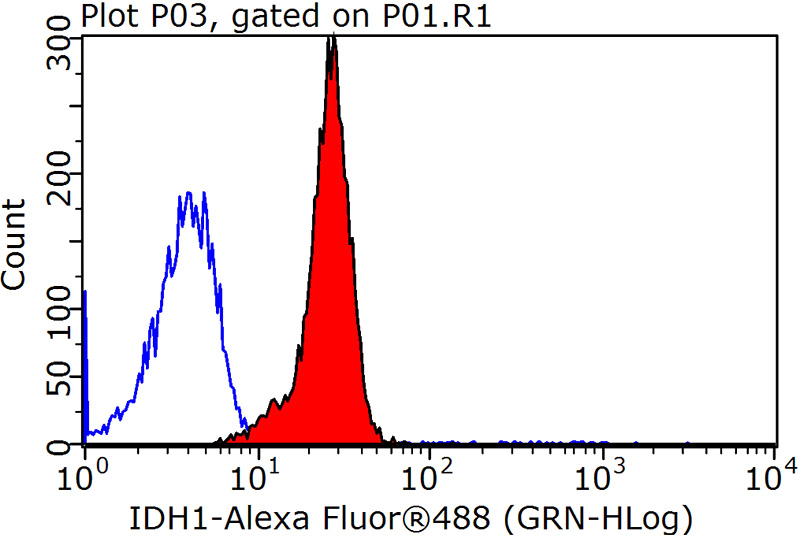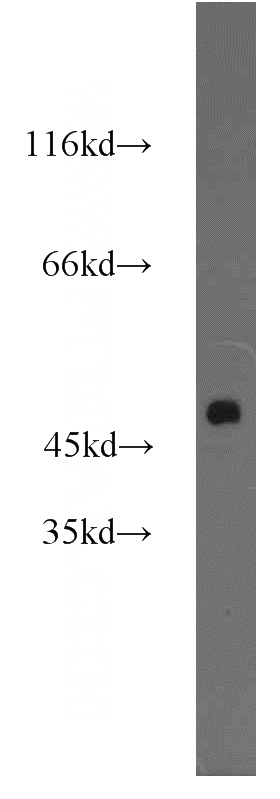-
Product Name
IDH1 antibody
- Documents
-
Description
IDH1 Rabbit Polyclonal antibody. Positive IHC detected in human gliomas tissue, human kidney tissue, human liver cancer tissue, human lung tissue, human placenta tissue, human skin tissue. Positive IF detected in HepG2 cells. Positive FC detected in HeLa cells. Positive WB detected in mouse liver tissue, DU 145 cells, HEK-293 cells, HeLa cells, HepG2 cells, MCF7 cells, mouse pancreas tissue, mouse small intestine tissue, NIH/3T3 cells, rat liver tissue. Positive IP detected in MCF-7 cells. Observed molecular weight by Western-blot: 47kd
-
Tested applications
ELISA, IP, IF, WB, IHC, FC
-
Species reactivity
Human,Mouse,Rat; other species not tested.
-
Alternative names
IDCD antibody; IDH antibody; IDH1 antibody; IDP antibody; IDPC antibody; NADP(+) specific ICDH antibody; Oxalosuccinate decarboxylase antibody; PICD antibody
-
Isotype
Rabbit IgG
-
Preparation
This antibody was obtained by immunization of IDH1 recombinant protein (Accession Number: NM_005896). Purification method: Antigen affinity purified.
-
Clonality
Polyclonal
-
Formulation
PBS with 0.1% sodium azide and 50% glycerol pH 7.3.
-
Storage instructions
Store at -20℃. DO NOT ALIQUOT
-
Applications
Recommended Dilution:
WB: 1:1000-1:10000
IP: 1:200-1:2000
IHC: 1:20-1:200
IF: 1:10-1:100
-
Validations

Immunohistochemical of paraffin-embedded human gliomas using Catalog No:111601(IDH1 antibody) at dilution of 1:50 (under 10x lens)

Immunohistochemical of paraffin-embedded human gliomas using Catalog No:111601(IDH1 antibody) at dilution of 1:50 (under 40x lens)

Immunofluorescent analysis of HepG2 cells using Catalog No:111601(IDH1 Antibody) at dilution of 1:25 and Rhodamine-Goat anti-Rabbit IgG

IP Result of anti-IDH1 (IP:Catalog No:111601, 3ug; Detection:Catalog No:111601 1:600) with MCF-7 cells lysate 2500ug.

1X10^6 HeLa cells were stained with 0.2ug IDH1 antibody (Catalog No:111601, red) and control antibody (blue). Fixed with 90% MeOH blocked with 3% BSA (30 min). Alexa Fluor 488-congugated AffiniPure Goat Anti-Rabbit IgG(H+L) with dilution 1:1500.

mouse liver tissue were subjected to SDS PAGE followed by western blot with Catalog No:111601(IDH1 antibody) at dilution of 1:2000
-
Background
IDH1, also named as PICD and IDP, belongs to the isocitrate and isopropylmalate dehydrogenases family. It is a common feature of a major subset of primary human brain cancers. It can form a homodimer(PMID:15173171).IDH1 mutation is always heterozygotic and IDH1 functions as a dimer, theoretically there will be 25% each wild type and mutant homo-dimers and 50% hetero-dimers present in the tumor cells(PMID:21079649 ).
-
References
- Dang L, White DW, Gross S. Cancer-associated IDH1 mutations produce 2-hydroxyglutarate. Nature. 462(7274):739-44. 2009.
- Ogihara T, Chuang JC, Vestermark GL. Liver X receptor agonists augment human islet function through activation of anaplerotic pathways and glycerolipid/free fatty acid cycling. The Journal of biological chemistry. 285(8):5392-404. 2010.
- Lu C, Ward PS, Kapoor GS. IDH mutation impairs histone demethylation and results in a block to cell differentiation. Nature. 483(7390):474-8. 2012.
- Su CC, Su JH, Lin JJ. An investigation into the cytotoxic effects of 13-acetoxysarcocrassolide from the soft coral Sarcophyton crassocaule on bladder cancer cells. Marine drugs. 9(12):2622-42. 2011.
- Li HH, Su JH, Chiu CC. Proteomic investigation of the sinulariolide-treated melanoma cells A375: effects on the cell apoptosis through mitochondrial-related pathway and activation of caspase cascade. Marine drugs. 11(7):2625-42. 2013.
- Cheng KC, Huang HH, Hung CT. Proteomic analysis of the differences in orbital protein expression in thyroid orbitopathy. Graefe's archive for clinical and experimental ophthalmology = Albrecht von Graefes Archiv für klinische und experimentelle Ophthalmologie. 251(12):2777-87. 2013.
- Fan J, Ye J, Kamphorst JJ, Shlomi T, Thompson CB, Rabinowitz JD. Quantitative flux analysis reveals folate-dependent NADPH production. Nature. 510(7504):298-302. 2014.
- Figueroa ME, Abdel-Wahab O, Lu C. Leukemic IDH1 and IDH2 mutations result in a hypermethylation phenotype, disrupt TET2 function, and impair hematopoietic differentiation. Cancer cell. 18(6):553-67. 2010.
Related Products / Services
Please note: All products are "FOR RESEARCH USE ONLY AND ARE NOT INTENDED FOR DIAGNOSTIC OR THERAPEUTIC USE"
